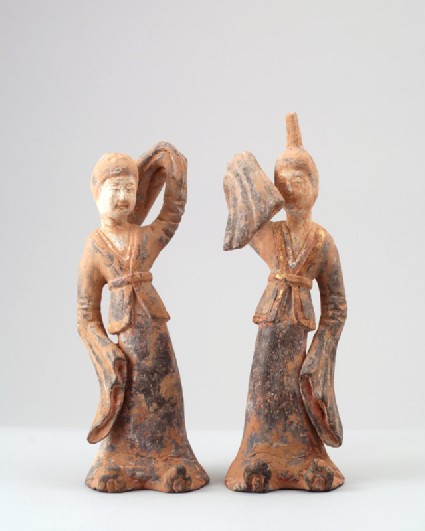The Barlow Collection
A select catalogue of the Barlow collection of Chinese Ceramics, Bronzes and Jades by the University of Sussex (published Sussex, 2006).

Publications online: 456 objects
Figure of a dancing lady with raised arm
- loan
-
Literature notes
Figures of dancing ladies are well known from the Tang dynasty (AD 618–907) and come in many different poses and outfits, but the present ones do not fall into the classic Tang repertoire. Their poses, hairdo and belted jackets do not conform with Tang styles, and while it is not impossble to find corresponding pairs of figures in the Tang, this is highly unusual, as tomb figures were generally not made in pairs but in larger series.
The figures are solidly made and very heavy, modelled as a corresponding pair, wearing long skirts and short jackets with overlong sleeves, one with her left arm raised and flapping the sleeve end backward, the other with the right arm raised with the sleeve end in front of her face, the shoes have bent-up tips. The hair is combed back and draped into a tall pointed bun. The grey pottery shows traces of a white dressing and red pigment. -
Details
- Associated place
- Date
- 1911 - 1934
- Material and technique
- earthenware, moulded, painted white, and with traces of red pigment
- Dimensions
- 30.2 x 9.5 x 9 cm (height x width x depth)
- Material index
- Technique index
- Object type index
- No. of items
- 1
- Credit line
- Lent by the Sir Alan Barlow Collection Trust.
- Accession no.
- LI1301.407.2
-
Further reading
University of Sussex, and Arts and Humanities Research Council, The Barlow Collection, supervised by Regina Krahl, Maurice Howard, and Aiden Leeves (Sussex: University of Sussex, 2006), no. S14
Glossary
earthenware
-
earthenware
Ceramic material made of clay which is fired to a temperature of c.1000-1200⁰c. The resulting ceramic is non-vitreous and varies in colour from dark red to yellow.
Location
-
- currently in research collection
Objects are sometimes moved to a different location. Our object location data is usually updated on a monthly basis. Contact the Jameel Study Centre if you are planning to visit the museum to see a particular object on display, or would like to arrange an appointment to see an object in our reserve collections.
Publications online
-

The Barlow Collection
Figures of dancing ladies are well known from the Tang dynasty (AD 618–907) and come in many different poses and outfits, but the present ones do not fall into the classic Tang repertoire. Their poses, hairdo and belted jackets do not conform with Tang styles, and while it is not impossble to find corresponding pairs of figures in the Tang, this is highly unusual, as tomb figures were generally not made in pairs but in larger series.
The figures are solidly made and very heavy, modelled as a corresponding pair, wearing long skirts and short jackets with overlong sleeves, one with her left arm raised and flapping the sleeve end backward, the other with the right arm raised with the sleeve end in front of her face, the shoes have bent-up tips. The hair is combed back and draped into a tall pointed bun. The grey pottery shows traces of a white dressing and red pigment.
Notice
Object information may not accurately reflect the actual contents of the original publication, since our online objects contain current information held in our collections database. Click on 'buy this publication' to purchase printed versions of our online publications, where available, or contact the Jameel Study Centre to arrange access to books on our collections that are now out of print.
© 2013 University of Oxford - Ashmolean Museum




